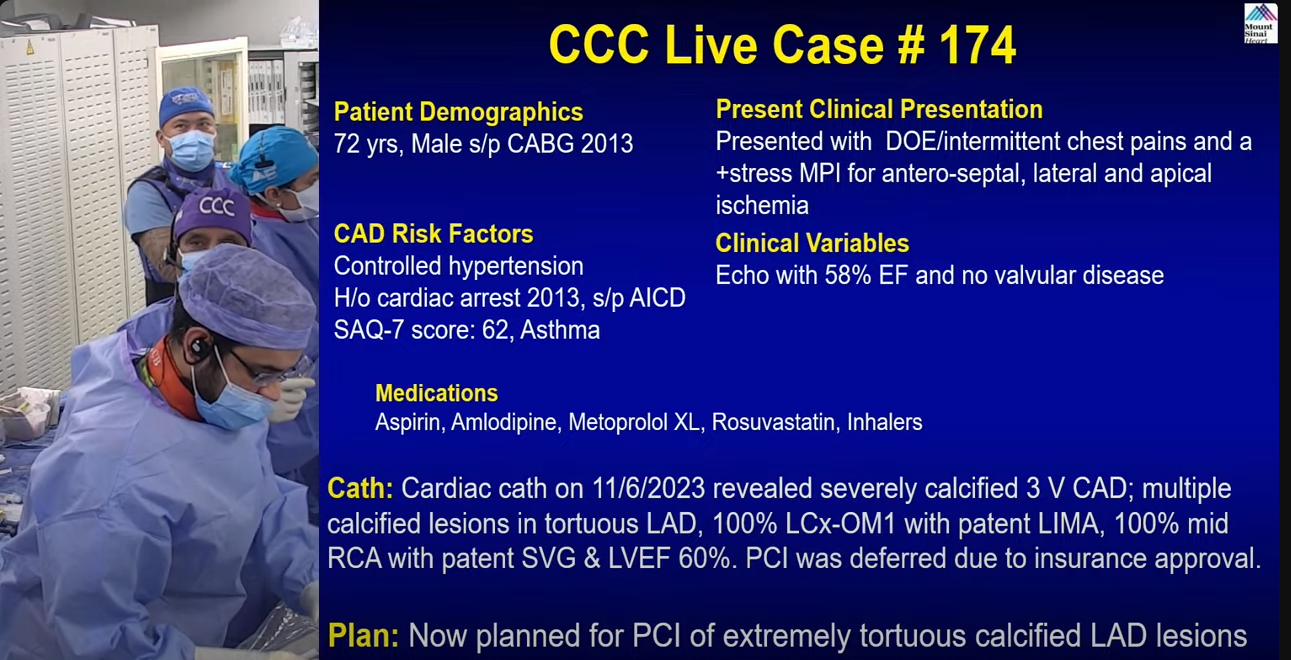Case and Plan
A 67-year-old male presented with exertional CCS angina Class II and mild inferior lateral ischemia on stress MPI. CTA revealed calcific multivessel CAD. A Cardiac Cath on 12/18/23 revealed extensive calcified 3 V CAD with multiple calcified 80-99% lesions in RCA, SYNTAX Score 35 and LVEF 60%. Patient was referred for CABG, but declined after Heart Team discussion due to patient’s wishes. Now planned for complex high-risk intervention of calcified RCA using Rotational Atherectomy + IVL and multiple DES.
Q&A
Q
Why do you feel Orbita-2 has not received large and positive press?
A.
Two reasons; 1) Orbita -2 showed benefit of PCI in terms of angina reduction only and not about the MACE and 2) Media as a general rule don't promote PCIs and are always anti-PCI. Hence despite being the first +PCI trial, we did not get the media highlight.
Q
Should the trial be extended to a longer duration?
A.
Long-term benefit of PCI will not be helpful in the Orbita-2 trial because of a small sample size (n=300pts) and also like earlier sham controlled Orbita trial, majority of the sham pts in the control group will undergo PCI after the unblinding procedure. To show the MACE benefit of PCI without vs on MT, we will need about 1000-1200 pts with 12–15mths follow-up.
Q
Where do you believe are the findings of Orbita 2 more relevant - in developed or in developing countries?
A.
Findings of Orbita-2 trial being very sophisticated trial design, is more applicable in developed countries rather than developing countries; where main function of PCI is to show lower MACE.
Q
Regarding today’s case, many operators would have squeamishly given up the case with the dissection and subintimal blush?
A.
Yes that is always a challenge in a long complex CTOs where little dye extravasation (‘cloud’) during the recanalization process deters us from using more aggressive guidewires. But waiting 15-20 minutes (like todays case) clears up the cloud and then process of CTO PCI continues. That persistence is needed to succeed and exactly was done in the current case to become successful.
Q
Was obtaining contra lateral access the main reason for success?
A.
Yes, as we well know having a contra lateral injection increases the success of CTO PCI by 20-25% and was a very important factor in this case.
Q
Tell us more about the Mongo wire?
A.
Mongo wire is a specialized hydrophilic wire based on the rope coil design helping to go thru the tortuous calcified lesions.
Q
Please write the order of preference of your use of support catheters?
A.
Finecross, Teleport followed by Corsair in the order of increasing preference in tough cases.
Q
And of guide extension catheters?
A.
Latest designs of both 6Fr Guidezilla and Guideliner gives equally good outcomes and support. Hence no separate recommendations.
Q
What are the main reasons for your success with NYS ratings?
A.
Main reasons for our success of PCI ratings of NYS are successful complex PCI procedures with low complications, close follow-up at 30 days about Pt’s well being and medication compliance and high volume of the majority of the interventionalists at MSH.
Q
Are there areas to improve further with these ratings?
A.
Yes most important area for improvement will be ability to exclude the deaths by noncardiac cause such as accidents, homicide/suicide and non PCI related causes such as rapidly progressive cancer, out of hospital sepsis or stroke.





